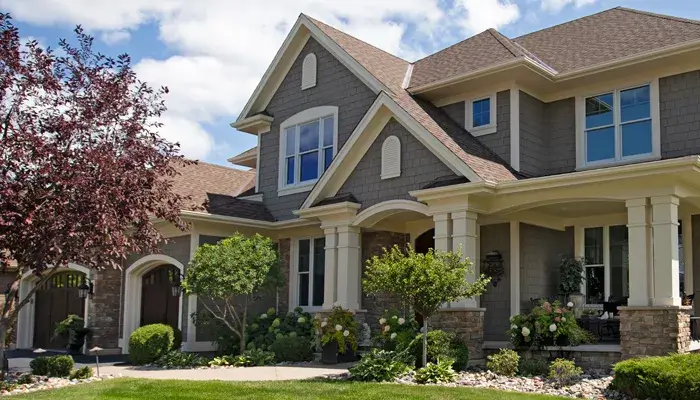How to Spot Signs of Subsidence
There are a four main types of movement that can have an impact in your home: subsidence, settlement, ground heave, and landslip. In this article, we investigate what is subsidence and what causes it as well as the signs to look out for.
What is subsidence?
Subsidence is an issue that often concerns property owners - and for good reason: It can be difficult to spot and costly to fix. In this article, we look at what subsidence is, how to spot it and how insurance may help to ease your concerns.
What is the meaning of “subsidence”?
Subsidence is when the ground beneath a building sinks, causing the foundation to become unstable and the structure to shift. This can result in serious damage to the building, including cracks in the walls, doors and windows that stick, and other signs of structural instability.
Is my house at risk of subsidence?
Properties built on a clay-rich soil and those with shallow foundations, near to vegetation are most at risk from subsidence damage. Oak, willow, hawthorn and sycamore trees can compound the issue as they require a lot of water and adapt to a drought by spreading their roots into new areas where they wouldn’t ordinarily grow.
What causes subsidence to houses?
Subsidence in a property can be caused by a number of factors. Some of the main causes of subsidence include:
- Tree or vegetation roots disturbing the ground and foundations beneath the home
- Clay soils increase the risk of subsidence as they shrink and swell depending on the water content (this is usually exacerbated by trees or vegetation)
- Leaking drains could cause the ground surrounding the foundations to soften or wash away
What are the tell-tale signs of subsidence?
It is not always possible to spot the earlier stages of subsidence, but there are a few key signs of structural movement to look out for, including:
- Doors and windows sticking
- Sloping floors - this is common in older properties
- If you have an extension, look for cracks where the extension meets the main part of the house.
What should I do if my house shows signs of subsidence?
Signs of subsidence should not be taken lightly. Should you spot signs of subsidence, it is important to seek expert advice and contact your insurer.
Only an expert will be able to provide suitable advice and the appropriate course of action, which may include underpinning (stabilising the foundations), removing any vegetation or trees, or in some instances demolishing and rebuilding (this is common with garages or extensions).
What can I do to reduce the chances of subsidence?
Unfortunately, there is only so much you can do to reduce the chances of subsidence - particularly if your home is in a subsidence-prone area. However, there are a number of preventative measures you can take to ensure that you are not contributing to the problem:
- Regularly check the foundation of your home for cracks or signs of instability.
- Avoid planting trees too close to your home. This is particularly important if you live in an area of clay soils. As a general rule of thumb, tree heights should not exceed distances from the property, but consult an arborist for guidance.
- Planting drought-resistant trees and shrubs, and reducing the amount of water used on the garden.
- If your house is already surrounded by large trees, consult a tree surgeon to find out what action you can safely take without causing further damage to your home. Sometimes, removing a tree or plant can cause further damage.
- Make sure that your guttering is well-maintained so as to avoid leaks, which could cause the ground to soften. You can also install a rainwater collection system, which can help to reduce the pressure on the soil during heavy rainfall.
- Maintain the proper level of humidity in your home, as excessive humidity can cause the soil to expand.
- Seek professional advice from a structural engineer or surveyor if there are concerns about subsidence.
If you are concerned about subsidence, it is important to contact your insurance provider as soon as possible. Many home insurance policies will provide coverage for subsidence damage, but it is important to have an accurate understanding of what is covered and what is not. An insurance professional can help you determine whether your policy provides adequate coverage for subsidence.
The impact of rising climate temperatures on subsidence
As temperatures rise, the risk of subsidence does too - heat and lack of rainfall causes clay soil to dry up and shrink, causing instability to building foundations.
The UK has seen a significant increase in the number of subsidence claims in recent years, due to a combination of factors, including prolonged dry spells, heatwaves, and heavy rainfall - an example of this was seen in 2018, when summer was marked by 12 weeks of little to no rain. These weather conditions can cause the soil to shrink or expand, which can lead to subsidence.
In the light of this, it is more important than ever to make sure you check your property for signs of subsidence, especially during the summer months. Heatwaves in 2018 and 2022 saw a huge surge in claims due to subsidence in high risk areas such as the South East and North London, and it is expected that the number of subsidence claims will continue to rise in 2023 due to the expected increase in extreme weather conditions.
In 2023, it is expected that subsidence claims will continue to increase, particularly in areas that have been affected by prolonged dry spells or heavy rainfall. This is because the soil is more susceptible to movement during these conditions, and the damage caused by subsidence may take several months to become noticeable.
What do I need to know about subsidence insurance coverage?
As a specialist insurance provider, Towergate aims to cover circumstances just like these and provide cover even if your property has a history of damage caused by ground movement. If you’ve been turned away elsewhere, speak to Towergate - we may be able to help.
In order to insure a property with a history of subsidence, we will need full details of: the cause; when subsidence occurred; the repairs that have been done; and copies of any surveys that have been carried out. If the occurrence was over five years ago, we may also ask for a more recent structural engineer's report.
What other structural issues should I look out for with my property?
As mentioned earlier, there are three other types of movement that can have an impact in your home: settlement, ground heave and landslip. These risks are usually grouped together by insurers so important to know what these terms mean:
Ground heave - In contrast to subsidence, ground heave is the upward movement of soil. It is usually associated with clay soils swelling due to a change in moisture levels. When the clay soil gets wet it expands and when it dries it shrinks. Many factors can contribute to this such as the death or removal of a tree, the weather or even a broken drain. One way to tell if the damage was caused by ground heave or subsidence is to look at the direction that the cracks in the walls and brickwork go in. Usually cracks caused by ground heave are vertical whereas subsidence cracks are diagonal.
Landslip – Also known as a landslide or ground slip, is the sudden sliding of soil down a hill which results in part of the foundations or property moving down a slope. It can also occur when part of the foundations is washed away.
Settlement - Settlement is usually limited to the first few years after a structure is built and is a natural part of the building process and is something you may experience if you move into a new or relatively new building. As the ground becomes compacted with the extra weight, small shifts occur as everything settles in. Builders will often return to a new property a few months after it has been finished to check and repair the minor cracks that can appear because of settlement.
Why is the excess for subsidence, ground heave and landslip usually higher than for other perils?
Generally, insurers do not pay for the cost to prepare any claim and excesses are usually included to avoid small claims from being submitted. With subsidence, ground heave or landslip, in order to ascertain that damage is from the insured event then an inspection by a suitably qualified professional is required. This means that the cost of this process is greater and requires a structural engineer’s report to be issued specifying remedial action.
Subsidence insurance from Towergate
For more information, visit our dedicated subsidence insurance page or call us on 0344 892 1750 to speak to a specialist adviser.
Date: July 19, 2023
Category: Other







